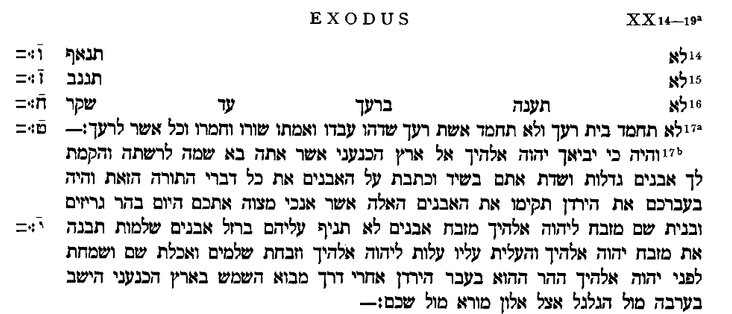Once you understand @INTF_MS’s system, you can call up any manuscript in the database. https://www.jdavidstark.com/what-you-need-to-know-to-use-intfs-document-id-system/ #textualcriticism @Bibel_Aktuell @eerdmansbooks
#textualcriticism
A modern Greek New Testament's critical apparatus holds a wealth of information. But when you're uncertain what it means, consult the MSS. https://www.jdavidstark.com/what-do-you-do-when-your-critical-apparatus-is-confusing/ @INTF_MS #textualcriticism @CSLewis @eerdmansbooks
Is #textualcriticism important for #spiritualformation? Irenaeus thought so, e.g., in his treatment of the variation between 616 and 666 in Rev 13. https://www.jdavidstark.com/irenaeus-on-666-and-616/
.@CSLewis wasn’t talking about #textualcriticism. But his thoughts on the value of reading old books definitely apply. https://www.jdavidstark.com/what-do-you-do-when-your-critical-apparatus-is-confusing/ @INTF_MS @eerdmansbooks
For each Greek New Testament MS, @INTF_MS’s document ID uses 5 digits. This ID can help you searching the database for a particular MS. https://www.jdavidstark.com/what-you-need-to-know-to-use-intfs-document-id-system/ #textualcriticism @Bibel_Aktuell @eerdmansbooks
Some objections to Rom 15–16 as part of the letter’s initial text. https://www.jdavidstark.com/the-textual-originality-of-romans-15-16-objections/ #textualcriticism @oxunipress @bakeracademic @wjkbooks
And in the Samaritan Pentateuch, it isn't an anachronism for God to have already chosen Mt. Gerizim, because in SamP's Ten Commandments (Exodus 20:17b), the tenth commandment is worship on Mt. Gerizim, in an addition not preserved in any other witness.
So I think we can explain the perfect tense verbs in "the place which God chose" to reflect Samaritan ideological revision to emphasize Mt. Gerizim, rather than SamP's textual priority here.
What does this mean?
We might be tempted to regard SamP as original (reflecting a composition date after "the choice" of Jerusalem) and MT as a correction to remedy the anachronism of Moses saying that God choosing Jerusalem was already a done deal.
But anachronism seems to have weighed much less heavily on ancient readers than modern ones.
And in the Samaritan understanding of the text, Jerusalem was not the place which God chose, but Mt. Gerizim!
#Deuteronomy 12 famously refers to a place YHWH will choose for his cult, which scholars often take as referring to Josiah's reforms (2 Kings 23). But in Deuteronomy the verbs are future tense (יבחר).
Or are they? SamP thinks otherwise.
All 21 times where the text refers to the place which God will choose (Deut 12:5, 11, 14, 18, 21, 26; 14:23-25; 15:20; 16:2, 6-7, 11, 15-16; 17:8, 10; 18:6; 26:2; 31:11), MT imperfect יבחר corresponds to SamP perfect בחר.
A Greek New Testament MS image might be a challenge to read. But reading it can be a helpful way of understanding your critical apparatus. https://www.jdavidstark.com/what-do-you-do-when-your-critical-apparatus-is-confusing/ @INTF_MS #textualcriticism @CSLewis @eerdmansbooks
Some reasons for thinking Rom 15–16 are original to the letter: https://www.jdavidstark.com/the-textual-originality-of-romans-15-16-additional-evidence/ #textualcriticism @eerdmansbooks @ZonderAcademic @hendricksonpub @twitterivp
Okay, a rabbit trail may have revealed a funny point about the NRSV's textual history.
#Genesis 10:14 = #1Chronicles 1:12 lists the peoples of Pathros, Kasluh, & Kaphtor, mentioning in passing that the Philistines came from Kasluhites.
Oddly, #Jeremiah 47:4 and #Amos 9:7 identify the Philistines as coming from Kaphtor, not Kasluh.
What's going on here? Dunno. Perhaps a marginal addition was incorporated into the main text in the wrong spot in Genesis.
1/?
I know that the presence or absence of matres lectionis (vocalic waw or yod) isn't meaningful, semantically or textually.
Yet often a verse differs in SamP and MT in that SamP has a mater lectionis in one word where MT lacks it, and MT has one where SamP lacks it.
E.g. #Numbers 22:1:
SamP: ויסעו בני ישראל ויחנו בערבת מואב מעבר לירדן יריחו
MT: וַיִּסְע֖וּ בְּנֵ֣י יִשְׂרָאֵ֑ל וַֽיַּחֲנוּ֙ בְּעַֽרְב֣וֹת מוֹאָ֔ב מֵעֵ֖בֶר לְיַרְדֵּ֥ן יְרֵחֽוֹ׃
1/?
Some reasons for thinking Rom 15–16 are original to the letter: https://www.jdavidstark.com/the-textual-originality-of-romans-15-16-additional-evidence/ #textualcriticism @eerdmansbooks @ZonderAcademic @hendricksonpub @twitterivp
A Greek New Testament MS image might be a challenge to read. But reading it can be a helpful way of understanding your critical apparatus. https://www.jdavidstark.com/what-do-you-do-when-your-critical-apparatus-is-confusing/ @INTF_MS #textualcriticism @CSLewis @eerdmansbooks
A Greek New Testament MS image might be a challenge to read. But reading it can be a helpful way of understanding your critical apparatus. https://www.jdavidstark.com/what-do-you-do-when-your-critical-apparatus-is-confusing/ @INTF_MS #textualcriticism @CSLewis @eerdmansbooks
We must use critical editions critically. I noticed that Von Gall's edition of #Exodus 27:9 reads באתה where MT reads בָֽאַמָּה֙, despite the fact that Kennicott's edition (which favors readings where SamP≠MT) does not note it. Is this a real variant, or just a typo?
In this case Von Gall's textual apparatus keys a variant to באמה, which occurs nowhere else in this verse, so the main text reading is presumably erroneous, merely a typographical error.
In #1Samuel 20:2, there's an interesting ketiv/qere:
K: לו־עשה
Q: לֹֽא־יַעֲשֶׂ֨ה
Hyphens & vowels were added later & word spacing is unreliable in ancient Hebrew manuscripts, so I wonder if there has been a w/y interchange here, and earlier it read ליעשה with negative L-.
In #Psalms 11:1 (10:1 in OG numbering), the verse ends:
MT: הַרְכֶ֥ם צִפּֽוֹר
your mountain, bird
OG: ἐπὶ τὰ ὄρη ὡς στρουθίον
to the mountains like a bird
= Pesh: ܥܠ ܛܘܪ̈ܐ ܐܝܟ ܨܦܪܐ
~ Vulg: in montem ut avis
Tg: לטורא/לטוריכון/ היך צפורא
to (the/your) mountains like a bird
Three strange features of MT strike me:
1. no "to"
2. no "like" a bird
3. "your" mountain
All 3 are unique to MT except that *part* of Tg tradition agrees with 3.
#HebrewBible #TextualCriticism
1/?
Has the New Testament been corrupted over time? 🧐 Let's look at the overwhelming manuscript evidence and the work of textual criticism. #BibleStudy #NewTestament #TextualCriticism"


